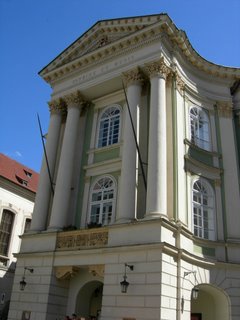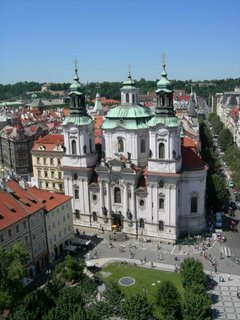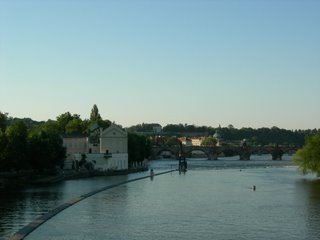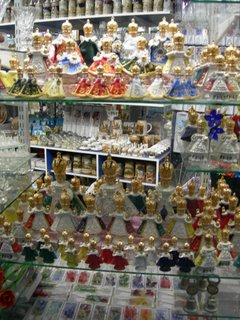Prague Day 2
In Search of Mozart and Kafka
This morning over a leisurely breakfast I tried to explain to Professor Otto how “Kafka” was a household word during my childhood, how my mom would say “It’s like Kafka!” to describe a certain type of difficult and frustrating situation, how my little sister would run through the house yelling, “Kafka! Ka fka!” when she was upset. I guess you had to be there.
fka!” when she was upset. I guess you had to be there.
After breakfast we walked down Na Porici, past the insurance company where Kafka worked, on the way to the Estates Theater, built in 1783 and site of the world premiere of Don Giovanni. What a combination.
At the Estates Theater, the retired conductor/music director, Pavel von Druscka, showed us around. We sat in the very seats where people had first watched Mozart conduct his final opera, and listened as the current maestro played hits from Figaro like “se vuol ballare” for us. He finished up his little concert with the Czech National Anthem, to such acclaim from the audience that he took us downstairs to the piano in the basement and played some Dvorak and Smetana pieces as well.
Chris took us over to the “Hussite” church, named after Jan Hus, who was an early reformer, burned at the stake 100 years before Luther got into trouble with the same people. Hus (or Huss, as we spell it in English) objected to a number of Catholic practices, including the selling of indulgences (sound familiar?) and the nice church fathers invited him down to the Council of Constance to discuss the issues. While there, they conveniently had a trial and burned Huss at the stake. My guess is that Luther knew about this, so when the nice church fathers invited him to come down to Rome he burned their invitation. In 1965, at Vatican II, the Catholic Church finally overturned Huss’ sentence, declaring him “i nnocent.” Thanks a lot, 550 years later.
nnocent.” Thanks a lot, 550 years later.
We strolled through the old Jewish quarter, known as Josefov, but didn’t have time to see it properly because we had to catch a bus out to Bertramka, the villa where Mozart stayed while finishing the overture at least for Don Giovanni, with his good friends the Dusecks, who also welcomed Beethoven in 1796.
There wasn’t a lot there, although we saw a room that they said might have been Mozart’s bedroom, a harpsichord they thought he might have played, and 13 hairs they claimed were from his head.
After the main group broke up, it was time to follow the amazing Professor Otto around again for the rest of the day. First we visited the huge Baroque-ized (I always thought it was Baroquified) Gothic church of St. James (since that’s my parish at home, and for a couple of other reasons, it was an important pilgrimage site) with the second longest nave in Prague, after the Cathedral. The place was gutted by fire in the 1690s, just in time for all those Italian Baroque guys to rush in and fix it up. I gave Chris a little test to see if he could find the Fischer von Erlach chapel (one of 20 chapels done by different people) – as you might imagine, it was easy peasy lemon squeezy for this particular individual (whose remarkable attributes and hotness I have already mentioned a number of times), even with the distraction of a 400 year old decomposing human forearm (I told you I loved Prague) hanging just inside the door. It seems that a thief tried to steal something from the church and one of the statues of Our Lady grabbed him and wouldn’t let go; the local butchers had to come and saw his arm off in order for him to be freed. Hm…sounds like a recent movie.
We visited the Kafka exhibit, which was brand new (about a year old) and really interesting, if somewhat pretentious, with phrases like “The I is an enigma and the community is entelechy” (neither of us knew what that word meant – any of you readers want to help me out?). We learned a lot about Kafka’s life and work – I particularly appreciated what Kafka said his main message was: “the only true foundation for the realization of all dreams is PATIENCE.” (does this ring a bell for anyone else?)
After the Kafka museum, Chris took me all around Prague. It was quite an experience, once again, to have a Cornell architecture professor with gorgeous blue eyes showing me all the sights - the Bata shoe building, the Grand Hotel Europa, the National Theater, Wenceslas Square…finding hidden little gems like Manet’s painting The Absynthe Drinker, learning what Modernism really is, and the difference between ‘mass’ and ‘volume’ or between ‘symmetry’ and ‘balance’ (he did this with dinner rolls, very hard to explain), about a photographer named Sudak who is the most important Prague photographer, and buying Infant of Prague fridge magnets. I told him the story of In the Penal Colony and tried to explain why I thought it was actually hilariously funny, but once again I guess you had to be there.
again, to have a Cornell architecture professor with gorgeous blue eyes showing me all the sights - the Bata shoe building, the Grand Hotel Europa, the National Theater, Wenceslas Square…finding hidden little gems like Manet’s painting The Absynthe Drinker, learning what Modernism really is, and the difference between ‘mass’ and ‘volume’ or between ‘symmetry’ and ‘balance’ (he did this with dinner rolls, very hard to explain), about a photographer named Sudak who is the most important Prague photographer, and buying Infant of Prague fridge magnets. I told him the story of In the Penal Colony and tried to explain why I thought it was actually hilariously funny, but once again I guess you had to be there. 
The many Infant of Prague dolls on sale!
In Search of Mozart and Kafka
This morning over a leisurely breakfast I tried to explain to Professor Otto how “Kafka” was a household word during my childhood, how my mom would say “It’s like Kafka!” to describe a certain type of difficult and frustrating situation, how my little sister would run through the house yelling, “Kafka! Ka
 fka!” when she was upset. I guess you had to be there.
fka!” when she was upset. I guess you had to be there.After breakfast we walked down Na Porici, past the insurance company where Kafka worked, on the way to the Estates Theater, built in 1783 and site of the world premiere of Don Giovanni. What a combination.

At the Estates Theater, the retired conductor/music director, Pavel von Druscka, showed us around. We sat in the very seats where people had first watched Mozart conduct his final opera, and listened as the current maestro played hits from Figaro like “se vuol ballare” for us. He finished up his little concert with the Czech National Anthem, to such acclaim from the audience that he took us downstairs to the piano in the basement and played some Dvorak and Smetana pieces as well.
Chris took us over to the “Hussite” church, named after Jan Hus, who was an early reformer, burned at the stake 100 years before Luther got into trouble with the same people. Hus (or Huss, as we spell it in English) objected to a number of Catholic practices, including the selling of indulgences (sound familiar?) and the nice church fathers invited him down to the Council of Constance to discuss the issues. While there, they conveniently had a trial and burned Huss at the stake. My guess is that Luther knew about this, so when the nice church fathers invited him to come down to Rome he burned their invitation. In 1965, at Vatican II, the Catholic Church finally overturned Huss’ sentence, declaring him “i
 nnocent.” Thanks a lot, 550 years later.
nnocent.” Thanks a lot, 550 years later.We strolled through the old Jewish quarter, known as Josefov, but didn’t have time to see it properly because we had to catch a bus out to Bertramka, the villa where Mozart stayed while finishing the overture at least for Don Giovanni, with his good friends the Dusecks, who also welcomed Beethoven in 1796.
There wasn’t a lot there, although we saw a room that they said might have been Mozart’s bedroom, a harpsichord they thought he might have played, and 13 hairs they claimed were from his head.
After the main group broke up, it was time to follow the amazing Professor Otto around again for the rest of the day. First we visited the huge Baroque-ized (I always thought it was Baroquified) Gothic church of St. James (since that’s my parish at home, and for a couple of other reasons, it was an important pilgrimage site) with the second longest nave in Prague, after the Cathedral. The place was gutted by fire in the 1690s, just in time for all those Italian Baroque guys to rush in and fix it up. I gave Chris a little test to see if he could find the Fischer von Erlach chapel (one of 20 chapels done by different people) – as you might imagine, it was easy peasy lemon squeezy for this particular individual (whose remarkable attributes and hotness I have already mentioned a number of times), even with the distraction of a 400 year old decomposing human forearm (I told you I loved Prague) hanging just inside the door. It seems that a thief tried to steal something from the church and one of the statues of Our Lady grabbed him and wouldn’t let go; the local butchers had to come and saw his arm off in order for him to be freed. Hm…sounds like a recent movie.
We visited the Kafka exhibit, which was brand new (about a year old) and really interesting, if somewhat pretentious, with phrases like “The I is an enigma and the community is entelechy” (neither of us knew what that word meant – any of you readers want to help me out?). We learned a lot about Kafka’s life and work – I particularly appreciated what Kafka said his main message was: “the only true foundation for the realization of all dreams is PATIENCE.” (does this ring a bell for anyone else?)
After the Kafka museum, Chris took me all around Prague. It was quite an experience, once
 again, to have a Cornell architecture professor with gorgeous blue eyes showing me all the sights - the Bata shoe building, the Grand Hotel Europa, the National Theater, Wenceslas Square…finding hidden little gems like Manet’s painting The Absynthe Drinker, learning what Modernism really is, and the difference between ‘mass’ and ‘volume’ or between ‘symmetry’ and ‘balance’ (he did this with dinner rolls, very hard to explain), about a photographer named Sudak who is the most important Prague photographer, and buying Infant of Prague fridge magnets. I told him the story of In the Penal Colony and tried to explain why I thought it was actually hilariously funny, but once again I guess you had to be there.
again, to have a Cornell architecture professor with gorgeous blue eyes showing me all the sights - the Bata shoe building, the Grand Hotel Europa, the National Theater, Wenceslas Square…finding hidden little gems like Manet’s painting The Absynthe Drinker, learning what Modernism really is, and the difference between ‘mass’ and ‘volume’ or between ‘symmetry’ and ‘balance’ (he did this with dinner rolls, very hard to explain), about a photographer named Sudak who is the most important Prague photographer, and buying Infant of Prague fridge magnets. I told him the story of In the Penal Colony and tried to explain why I thought it was actually hilariously funny, but once again I guess you had to be there. 
The many Infant of Prague dolls on sale!


1 Comments:
At 1:59 AM, Anonymous said…
Anonymous said…
Hey Adina, you world traveller you, Prague sure does look glorious in those pictures. I hope that the rest of your European excursion is as beautiful. Can't wait to see you in the fall.
Post a Comment
<< Home